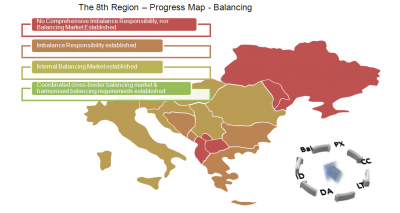
The SEE RAP foresee the
establishment and existence of operational organised market structures as
prerequisites for the day-ahead timeframe power exchanges. Nerveless, the SEE
region’s TSOs are still running a coordinated capacity calculation process
based on a rotational sharing of model merging responsibility. In more, it is
still in the early begin – mainly the Croatia and Serbia to which has join at the begin of July 2015 the Albanian – of the consideration in the establishment of organised market.
 Then the Cross-Border Intraday Trading are largely of bilateral nature
Then the Cross-Border Intraday Trading are largely of bilateral nature
and based on a first-come-first-serve allocation principle. In more, actually it
is possible in the SEE Regions’ interconnectors between the bidding zones
operated by the following TSOs: CGES, HOPS, EMS/KOSTT, NOSBIH.
In same time, the development of the electricity balancing market in the
SEE Region – but also in some EU Member States – is characterised by the nationally
oriented approach to balancing. The implementation of the 2nd Energy
Package requirements for market-based, non-discriminatory and transparent
system balancing and imbalance settlement so far has been the exception rather
than the rule.
 In additional, the obligation of establishing a well-functioning balancing
In additional, the obligation of establishing a well-functioning balancing
markets and their regional integration is strengthened by the 3rd
Package which was to be implemented in the Contracting Parties as of 1 January
2015. Nevertheless, until now, only Albania and Serbia has adopted in the WBs a
new law based on the 3rd package. Besides that, negotiations between
the TSOs of the Control Blocks comprising the SEE Region are ongoing regarding
the common procurement and sharing of balancing reserves.
Focusing here to Albania, the requirements of Article
11 of Directive 2003/54/EC in the context of balancing were not transposed in
the Power Sector Law. Balancing groups, the mechanism of netting out of
positive and negative imbalances, balance responsibility of KESH and OSHEE and
reference price for imbalances and incentive conditions for accurate
nominations have not been defined. In practice, KESH is balancing the entire
system.
The
cost for positive imbalances corresponds to its (regulated) price, whereas the
price for negative imbalances are calculated by adding a surcharge on the
import price of KESH (either 10% or the average price of independent power
producers + 20% when KESH did not import). The principle of cost-reflectivity
applies only for traders and eligible customers. The large hydro power plants
connected to the transmission network do not bear balance responsibility nor
are they subject to individual costs of imbalance.
The
enactment the new Law of the Electricity Sector no 43 on 30th April
2015 which aim a fully aligned with Directive 2009/72/EC of the European
Parliament and the Council, dated 13 July 2009 “On common rules for the
internal market in electricity”, on the part of Market Rules establish that
ERE, upon proposal of the Transmission System Operator and in collaboration
with all participants of the electricity sector, shall adopt the Electricity
Market Rules, in accordance with this law and the Electricity Market Model,
including the rules for planning, dispatching, balancing, settlement of
disputes and requests for reserve management. The Market Rules shall be adopted
by the ERE, within 1 (one) year from the date of entry into force of this law.
In
regard, the balance responsibility of electricity market participants, each
participant of the electricity market will be responsible for the electricity
balance. Electricity market participants may arrange their balance
responsibility by concluding a balance responsibility contract with the
Transmission System Operator, thus acquiring the status of a balance
responsible party, or by signing a contract on transferring the balance
responsibility to another balance responsible party, thus becoming a member of
the balancing group of this balance responsible party, in accordance with the
market rules.
In last for what here in consideration, the Market
Operator is responsible for preparing financial statements for payment of the
reciprocal obligations for the imbalances caused by market participants. The
way of imbalances’ treatment caused from the priority producers of electricity
and respective costs for their coverage are subject of Council of Ministers’
approval.
Then, with a
fully implementation of the above prevision of the Law 43 / 2015, all actions and processes through which the transmission system
operator operates and maintains the system frequency within predefined
stability range have to came through market-based management of the functions
of balancing of the power system operated by the Transmission System Operator. The
obligation of market participants “Balancing responsibility” to balance
generation, consumption, and electricity purchase or selling processes have to
came in accordance with the accepted schedule being financially responsible to
the Transmission System Operator for the settlement of imbalances. The all through
the definition in the “Market Rules” means the rules developed by the Market
Operator with the approval by ERE.
The here communication came within the framework of
preparation of the analytic report, to be release in short upcoming period by
ACERC, about liberalisation and organised market in Albania. In cases of
interest to the directly involvement as author with analyses or for any kind of
support and partnership, contact us at the info@albaniaenergy.org. For more
keep update with the EU & WBs
/ Albania Energy Regulatory Updates or visit the Official Page of ACERC.